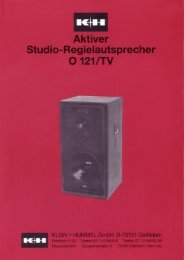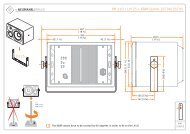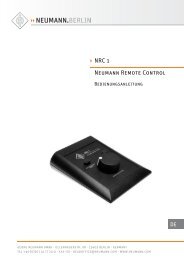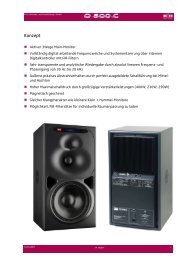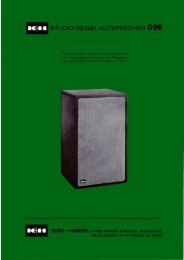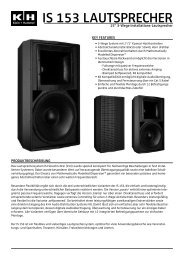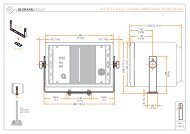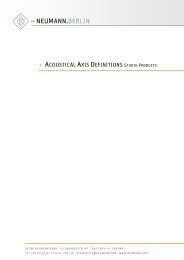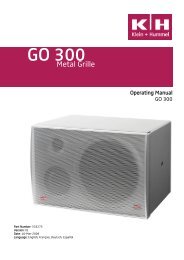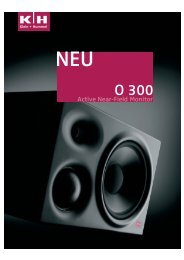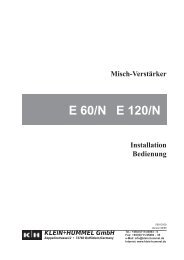TRA 100 - Georg Neumann GmbH
TRA 100 - Georg Neumann GmbH
TRA 100 - Georg Neumann GmbH
You also want an ePaper? Increase the reach of your titles
YUMPU automatically turns print PDFs into web optimized ePapers that Google loves.
Portable<br />
PA Speakersystem<br />
<strong>TRA</strong> <strong>100</strong><br />
Installation<br />
Setup<br />
Operation<br />
058-E0095<br />
Valid since W - No. 2373, Version 19-03-2003<br />
Tel.: + 49 - (0)711 - 45893 - 0<br />
KLEIN + HUMMEL <strong>GmbH</strong> Fax: + 49 - (0)711 - 45893 - 35<br />
e-Mail: info@klein-hummel.de<br />
Zeppelinstr. 12 73760 Ostfildern/Germany<br />
Internet: www.klein-hummel.de
Safety Instructions<br />
It is absolutely essential that you read these safety instructions carefully before connecting and using this K+H<br />
product. Your safety depends on it. Furthermore, failure to follow these instructions voids the warranty. To ensure<br />
safe operation for years to come, keep these instructions in a safe place for future reference. K+H has manufactured<br />
this product in accordance with IEC 1992 (SEC) 39 standards, then tested and delivered it in safe operating condition.<br />
To maintain it in this condition, you must:<br />
• observe all safety instructions,<br />
• use the product only as described herein,<br />
• have any maintenance, repairs, or modifications performed only by K+H or other authorized personnel, and<br />
• ensure that the room in which you use this product is wired in accordance with the local electrical code.<br />
Warning!<br />
• When the interior of the cabinet is exposed, touching some parts can lead to an electric shock.<br />
• If you need to gain access to the interior electronics of the unit, always disconnect the unit from any and all power<br />
sources first.<br />
• Any repairs, maintenance, or other service of the unit when its interior compartment is exposed may only be<br />
performed safely (in accordance with VBG 4) by authorized technicians familiar with all the<br />
risks involved. Even in an unplugged state, a fully charged capacitor in the unit can zap the<br />
unsuspecting.<br />
• Loudspeaker output jacks labeled with the IEC 417/5036 emblem (Fig. A, right) may be carrying<br />
dangerously high voltages. If your unit has this emblem, ensure that any connections to be<br />
made between these jacks and the speakers themselves are made before powering up the<br />
unit, and are done so only with manufacturer-approved interconnecting cables.<br />
• If you need to replace any fuses, ensure that the replacements are of exactly the same type,<br />
value and voltage as the originals, as spelled out in the technical specifications at the rear of Fig. A<br />
this manual.<br />
• Do not use "repaired" fuses.<br />
• If you do not have any fuses on hand of the specified size, type, and value, do not hot-wire the<br />
contacts in the holder by short-circuiting them.<br />
• Certain areas of the cabinet, cover, and rear panel can achieve extreme temperatures and are<br />
therefore marked with a "HOT" label (Fig. B). Refrain from touching any heat sink or ventilation<br />
grille.<br />
• High volume levels are known to cause permanent - i.e. irreversible - hearing damage, especially<br />
when listened to without sufficient breaks. The higher the levels, the more frequent and extended<br />
must be the breaks. Avoid standing too close to loudspeakers that are being driven at high Fig. B<br />
levels. If you must be exposed to high sound pressure levels over an extended period of time,<br />
use hearing protection.<br />
Mains Connection:<br />
• This unit is designed for continuous operation.<br />
• Ensure that the operating voltage of the unit matches that of the local mains current (AC line voltage).<br />
• Always check before connecting the power cable to the mains socket that the power switch on the unit itself is set<br />
to off ("O").<br />
• Use the power cable or power supply that came with the unit to connect to the mains socket (wall outlet).<br />
• Power supply: a damaged power cable may not be repaired. Use a new cable.<br />
• Avoid plugging the mains cable into a power strip that already has several other power-consuming devices<br />
connected to it.<br />
• Avoid using extension cables. The unit must be connected to a mains socket close to it, and that socket should<br />
be freely accessible.<br />
Installation:<br />
• This product may only be placed on a stable, clean, horizontal surface.<br />
• Do not expose this product to vibration.<br />
• Do not operate this product anywhere near water or other liquids. Do not use it near a sink, swimming pool,<br />
bathtub, or in any damp room or area. Electrical shocks carried through water can kill. Do not place any beverages<br />
whatsoever on or near this product, as liquids can kill electronic components.<br />
• Ensure sufficient ventilation around the product to allow for adequate heat dissipation, especially near the rear<br />
panel and the sides of the cabinet (minimum of 8 inches from the nearest wall). The unit may only be installed in<br />
a rack if measures are taken to ensure sufficient ventilation and if the mounting instructions of the manufacturer<br />
are followed. Do not block or cover any heat sink, fan, or vent.<br />
• Do not place the product where it will be in the path of direct sunlight, and keep it a safe distance away from<br />
radiators and other heaters of any kind.<br />
• If you bring this product from a cold environment into a warm one (such as from a vehicle into a studio), it is quite<br />
possible that condensation will form inside the cabinet. Please allow the unit sufficient time for acclimatisation<br />
to room temperature (minimum thirty minutes) before connecting and powering up.<br />
• To avoid accidents, do not use any accessory equipment with this product which is not approved by the manufacturer,<br />
particularly mounting accessories. Do not place this unit on any unstable platform, cart, stand or table. Should the<br />
unit fall, it can cause bodily injury to persons, or can be damaged itself.<br />
• To protect this product from lightning damage during a thunderstorm or from power surges during an extended<br />
absence, disconnect the power cable from the wall outlet.<br />
Page 2 Portable PA Speakersystem <strong>TRA</strong> <strong>100</strong>
This manual contains:<br />
Safety Instructions.........................................2<br />
1. Connection and setup..............................5<br />
1.1 Safety hint................................................5<br />
1.2 This box contains.........................................5<br />
1.3 Conditions for operation.................................5<br />
1.4 Positioning................................................5<br />
1.4.1 On a tripod...................................................5<br />
1.4.2 Wall or ceiling mounting.................................5<br />
1.4.3 Adjustment of the <strong>TRA</strong> <strong>100</strong>............................5<br />
1.5 Connection to AC..........................................5<br />
1.6 Ground Lift switch.........................................5<br />
1.7 Fuses.......................................................5<br />
1.8 External 12 to 16 V power...............................5<br />
1.9 POWER switch............................................6<br />
1.10 POWER ON LED..........................................6<br />
1.1 LED..........................................................6<br />
1.12 Low-Battery protection...................................6<br />
1.13 Connection of audio sources..........................6<br />
1.13.1 Input 1.........................................................6<br />
1.13.2 Input 2.........................................................7<br />
1.13.3 Input 3.........................................................7<br />
1.14 AF and DC outputs........................................7<br />
1.14.1 LINE out.......................................................7<br />
1.14.2 REC out.......................................................7<br />
1.14.3 Monitor speaker............................................7<br />
1.14.4 DC out.........................................................7<br />
Illus. 1<br />
Front view<br />
2. Operation......................................................8<br />
2.1 Using a dynamic MIC and talking to it from<br />
a distance....................................................8<br />
2.2 Using a dynamic MIC for close-up talking........8<br />
2.3 Using an electret-condenser MIC and talking<br />
to it from a distance.......................................8<br />
2.4 Using an electret-condenser MIC for loud<br />
closeup speech or singing.............................8<br />
2.5 Connecting a mixer or any unit with LINE level.8<br />
2.6 Recording from the <strong>TRA</strong> <strong>100</strong>...........................8<br />
2.7 Tone-Control.................................................8<br />
2.7.1 Low..........................................................8<br />
2.7.2 Mid...........................................................8<br />
2.7.3 High.........................................................8<br />
2.8 Remarks to the internal rechargeable battery<br />
(accumulator)............................................9<br />
2.9 Spare unit and disposing of defective batteries........9<br />
3. In case of a problem..................................10<br />
4. Diagrammes..........................................11-12<br />
5. Warranty......................................................12<br />
6. Technical specifications....................13-15<br />
Portable PA Speakersystem <strong>TRA</strong> <strong>100</strong> Page 3
Illus. 2<br />
Rear view of the system<br />
The numbers in circles are<br />
referred to in the following text<br />
Page 4 Portable PA Speakersystem <strong>TRA</strong> <strong>100</strong>
1. Connection and Setup<br />
1.1 Please read carefully and obeye the<br />
safety instructions on page 2!!<br />
!<br />
When this speaker-system is operated in<br />
an area above the audience, i.e. hanging<br />
from the ceiling, mounted to a crossbar,<br />
hanging on the wall etc. you must make<br />
sure to provide an additional safety-rope,<br />
tightened to the handle!!<br />
1.2 This box contains<br />
1x active PA speaker-system <strong>TRA</strong> <strong>100</strong><br />
1 x Power cord (Mains cable)<br />
1 x operation manual<br />
1.3 Conditions for operation<br />
The active PA speaker system <strong>TRA</strong> <strong>100</strong> has been<br />
designed to work in a temperature-range from –10° C<br />
to +40° C. During storage or transport temperatures<br />
below –15° C will freeze the electrolytic GEL inside<br />
the rechargeable battery and may destroy it.<br />
The <strong>TRA</strong> <strong>100</strong> can be operated in any position.<br />
This unit should not be exposed to high moisture,<br />
watersplashes, heavy rain etc. It should be used in<br />
low humidity areas only. K+H is offering an optional<br />
raincover, which will protect the system during rain.<br />
Areas with aggressive chemical pollution or high<br />
density of dust should be avoided.<br />
This active PA-system is not designed for permanent<br />
open air installations.<br />
The cones of the speakers are covered with a thin<br />
plastic-film as a protection against moisture and fog,<br />
but there should not be any condensing water on the<br />
speakers.<br />
If after transportation or longer storage in humid<br />
and cold surroundings the system should show<br />
condensed dew on the box or the rear panel, please<br />
allow at least 2 hours for acclimatisation, before<br />
you switch ON the system.<br />
1.4 Positioning<br />
1.4.1 On a tripod:<br />
In the bottom of this unit you will find a speaker<br />
stand-adaptor with a 35mm diameter to accept all<br />
tripods and stands designed in that format. With<br />
the LH 33 adaptor the <strong>TRA</strong> <strong>100</strong> can be tilted in any<br />
angle between 0° and 15° related to the vertical<br />
position.<br />
The LH 26 is a U-shaped bracket, which can be<br />
mounted to the <strong>TRA</strong> <strong>100</strong> with 2 x M8<br />
locking screws. This bracket can be mounted to<br />
any 35mm tripod, when it is fitted with the LH 28<br />
tripod-adaptor.<br />
1.4.2 Wall or ceiling mounting:<br />
The <strong>TRA</strong> <strong>100</strong> is fitted with a number of M 8 threaded<br />
holes on the top and the sides of the cabinet, to<br />
allow for various mounting hardware. On top are<br />
2 x M 8 with a distance of 115 mm, so a TV -<br />
spigot LH 29 can be fitted.<br />
The wall-mount adaptor LH 120 will carry the <strong>TRA</strong><br />
<strong>100</strong> on it’s 35mm adaptor and it also allows to tilt<br />
the speaker in any angle between 10° to 25° related<br />
to the vertical position.<br />
1.4.3 Adjustment of the <strong>TRA</strong> <strong>100</strong><br />
Please take care that no microphone will be<br />
positioned directly in front of the speaker to prevent<br />
feedback and howl. The mikes should always be<br />
behind the system, and all levels should be set<br />
low, so no feedback or ear-damage could occur.<br />
1.5 Connection to AC<br />
The <strong>TRA</strong> <strong>100</strong> has been designed to work with an AC<br />
power input of 230V / 50-60 Hz. For the USA the unit<br />
is supplied with a 117 V / 60 Hz transformer.<br />
The power-cords are according to local specifications,<br />
the special AC-plug needed in your country should<br />
only be mounted by a skilled electrician. Please make<br />
sure that all three wires are properly connected and<br />
the “yellow-green” protective earth wire should not be<br />
isolated!<br />
1.6 Ground Lift switch<br />
In rare cases there might be an audible hum, when<br />
the <strong>TRA</strong> <strong>100</strong> is connected to other appliances, which<br />
are also grounded. In these cases you may activate<br />
the GROUND LIFT switch, to disconnect the <strong>TRA</strong> <strong>100</strong><br />
from the ground back. Please make sure to set this<br />
switch back to the NORMAL position when you set it<br />
up in a new location!<br />
1.7 Fuses<br />
The <strong>TRA</strong> <strong>100</strong> carries two fuses, which should only be<br />
exchanged when the unit is switched OFF and the<br />
power cord is taken out of the AC outlet!<br />
a) Power fuse 230V (or 117 V) next to the AC-input:<br />
T 1 A for 230 V (slow blow)<br />
T 2 A for 117 V (slow blow)<br />
b) Battery fuse in the round holder under the Powerswitch:<br />
T 6,3 A (slow blow type) 4<br />
1.8 External 12 to 16 Volt power<br />
The <strong>TRA</strong> <strong>100</strong> is designed to work with any external<br />
DC from 12 to 16 volts. The extern battery input can<br />
be accessed by removing the protection cover. We<br />
can supply the special plug for this connector. Please<br />
Portable PA Speakersystem <strong>TRA</strong> <strong>100</strong> Page 5<br />
1<br />
2<br />
3<br />
5
take care for correct connection of the + and – wires<br />
from your external power source. In case you mix up<br />
the correct connection, the system will not be<br />
damaged, but it will keep on working on the internal<br />
battery.<br />
1.9 POWER switch<br />
This POWER switch has three positions:<br />
Pos. O = System is switched OFF, but the internal<br />
rechargeable battery is in CHARGE mode.<br />
Pos. I = System is ON, less MIC receiver is ON,<br />
battery is in CHARGE mode.<br />
Pos. II = System is ON, wireless MIC receiver is OFF<br />
rechargeable battery is in CHARGE mode.<br />
If you have the <strong>TRA</strong> <strong>100</strong> with a built-in wireless MIC<br />
receiver, you should use the <strong>TRA</strong> <strong>100</strong> in the switchmode<br />
Position II (if receiver not used) to save energy<br />
for an extended operation-time of the system.<br />
When switching from Pos. I to Pos. II you should at<br />
least allow a pause of 5 seconds, to avoid the low<br />
battery protection system (see 1.12) becoming active.<br />
It is not possible to switch off the <strong>TRA</strong> <strong>100</strong> remotely<br />
by pulling the mains-plug! In this case the <strong>TRA</strong> <strong>100</strong><br />
automatically will switch to the internal battery-supply.<br />
1.10 POWER ON LED<br />
When the <strong>TRA</strong> <strong>100</strong> is switched ON, the green<br />
POWER ON LED will be illuminated. After a delay of<br />
about 3 seconds the system is ready to work.<br />
When in battery-mode this green LED also is used for<br />
capacity display of the battery. If the rechargeable<br />
battery has reached a capacity of 25%, this LED will<br />
start flashing slowly. With a lower capacity this LED<br />
will be blinking faster, so you can see that there will<br />
be only 20 to 30 minutes of operation left from that<br />
battery.<br />
1.11 Loading LED<br />
Charging the battery<br />
If you want to charge the rechargeable battery, you<br />
must connect it to a powered mains outlet and set the<br />
power switch 6 to pos. 0.<br />
When the system is charging the battery, the red LED<br />
will be on. When the battery is very low, recharging<br />
will take about 6 hours to reach a capacity of ca. 90%<br />
and about 10 hours for a capacity of <strong>100</strong>%. When the<br />
battery is fully charged, the red LED will be off and<br />
the internal electronics will be in a standby charge<br />
mode. This standby charging system has been<br />
designed in a way that the <strong>TRA</strong> <strong>100</strong> can stay connected<br />
to the mains all the time.<br />
The charge electronics will power up the rechargeable<br />
battery smoothly and effectively – no matter how low<br />
6<br />
8<br />
7<br />
it is. It is completely separate from the main PSU<br />
system of the <strong>TRA</strong> <strong>100</strong>, so full operation of the system<br />
and recharging the battery is possible, even if the<br />
<strong>TRA</strong> <strong>100</strong> has to deliver <strong>100</strong> W RMS!<br />
After having purchased the <strong>TRA</strong> <strong>100</strong> you should<br />
connect it to the mains for about 6 hours to recharge<br />
and fully load the battery. When the <strong>TRA</strong> <strong>100</strong> has not<br />
been used for a longer time, it also should be<br />
connected to the mains to fully recharge the battery.<br />
When the <strong>TRA</strong> <strong>100</strong> is connected to an external battery<br />
or PSU the internal battery will not be re-charged.<br />
It is not possible to charge smaller, external batteries<br />
from the DC-output of the <strong>TRA</strong> <strong>100</strong>.<br />
1.12 Low battery protection<br />
When the battery is used and its capacity drops under<br />
a certain level, it may be damaged or destroyed. To<br />
avoid this situation, a low-battery protection is built<br />
into the unit which will switch off the battery before it<br />
will reach this low level status.<br />
When this is happening during the <strong>TRA</strong> <strong>100</strong> is in<br />
operation on the internal battery, please switch off<br />
the unit with switch 6 and take the first chance to<br />
fully recharge the battery.<br />
1.13 Connection of audio sources<br />
All inputs of the <strong>TRA</strong> <strong>100</strong> have an overload headroom<br />
of min. 10 dB.<br />
1.13.1 Input 1<br />
Input 1 is an electronically balanced input to<br />
accept a wide range of sound sources from professional,<br />
semi-pro, or portable devices. For a<br />
perfect matching of levels and impedances we<br />
have provided a 3-position switch 10 to select for:<br />
LINE 0 dBu<br />
AUX –25 dBu<br />
MIC –45 dBu<br />
The connector socket is designed to accept ¼”<br />
MONO or STEREO jacks or 3-pin XLR plugs. The<br />
XLR connector is wired as follows:<br />
Combo - socket balanced<br />
female:<br />
1 = Ground<br />
2 = + signal<br />
3 = - signal<br />
Page 6 Portable PA Speakersystem <strong>TRA</strong> <strong>100</strong><br />
9
The ¼” jack is wired as follows:<br />
Tip = + signal<br />
Ring = - signal<br />
Frame = Ground<br />
When using unbalanced signal sources, please<br />
solder a bridge between ring and frame in your<br />
¼” jack or between the minus PIN 3 and the ground<br />
of your XLR plug.<br />
In the setting MIC and AUX of the rotary switch<br />
the <strong>TRA</strong> <strong>100</strong> also applies phantom power to the<br />
input-socket, so you can connect powered<br />
condenser microphones to that input via balanced<br />
XLR or jack!<br />
Please note, that only balanced Mics are<br />
connected to the phantom powered input of the<br />
<strong>TRA</strong> <strong>100</strong>. So your microphone should be connected<br />
with two wires and a screen to it’s connector.<br />
!<br />
Please note that you cannot use a MONOjack<br />
to apply phantom power!<br />
1.13.2 Input 2<br />
This is a transformer balanced input for balanced<br />
¼” jacks or 3-pin XLR plugs, accepting all kind of<br />
signal sources. Again we have provided a<br />
3-position switch for:<br />
13<br />
LINE +6 dBu<br />
AUX –25 dBu<br />
MIC –65 dBu<br />
Pinlayout is as described for INPUT 1.<br />
Input 2 is ideal for dynamic microphones when in<br />
pos. MIC –65 dBu, or for balanced signals from<br />
professional sources or a crosslink from an OBvan<br />
when in the LINE +6 dBu setting.<br />
1.13.3 Input 3<br />
12<br />
15<br />
This is an unbalanced CINCH input, which is ideal<br />
to connect CD-or MD-players, Walkman or similar<br />
high-level sources to it. The L+R inputs are summed<br />
for a MONO signal.<br />
With the level control VOLUME 3 16 you can add<br />
the connected source to your mix.<br />
1.14 AF and DC outputs<br />
1.14.1 LINE OUT<br />
The electronically balanced XLR output carries the<br />
MIX-signal of the <strong>TRA</strong> <strong>100</strong> preamp. So you may<br />
connect other mixers, or a camera etc. to this unit.<br />
The connections are as follows:<br />
XLR-socket balanced male<br />
1 = Ground<br />
2 = + signal<br />
3 = - signal<br />
If you want to connect an unbalanced input to this<br />
socket, please make sure to have a bridge<br />
between pin 1 and 3 in your external connector.<br />
The nominal level at this socket is +6 dBu, the<br />
max. level is +17 dBu.<br />
1.14.2 REC OUT<br />
At this output you can connect any MD, cassette<br />
or other recorder, accepting a reference-level of<br />
- 6dBu. The MONO output signal is on both sockets,<br />
so recordings will be in MONO. The connection<br />
from this output to any recorder should be made<br />
to the LINE IN socket of the external unit.<br />
1.14.3 Monitor speaker<br />
This jack-socket carries an output of 15 W RMS/<br />
4 Ohms to connect any passive add- on speaker,<br />
so you can cover a larger space with the <strong>TRA</strong> <strong>100</strong>.<br />
This output is adjustable via the VOLUME Monitor<br />
speaker control. 21<br />
1.14.4 DC OUT<br />
K+H have provided a 6 V DC output for the PSU of<br />
external units, such as MD, CD, cassette-decks<br />
or external RF-receiver. This output is short-circuitproof<br />
and stabilized. It can be selected for 3 V or<br />
9 V by an internal jumper.<br />
Special care has to be taken when connecting<br />
external units to this DC output!<br />
Please do not mix up the + and – of your<br />
external supply input, as KLEIN + HUMMEL can<br />
not be held responsible for any<br />
1.13.4 Internal input for RF-receiver<br />
The <strong>TRA</strong> <strong>100</strong> is fitted with a slide-in compartment<br />
to accommodate one or two wireless microphone<br />
receivers from almost any manufacturer. In some<br />
cases special mechanical adaptions have to be<br />
made by the customer or his dealer. For a number<br />
of standard units K+H is offering special cover<br />
plates, so you can adjust level or frequency of<br />
your receiver.<br />
To adjust your wireless MIC in the mix, K+H have<br />
damage caused to external units.<br />
You also should take care of the !<br />
correct grounding of your external<br />
unit! In some units the + of the PSU is connected<br />
to the ground (or the – of your LINE-output<br />
socket) of your player! Make sure and check<br />
with your dealer first!<br />
Any unit connected to this DC output will reduce<br />
the capacity of the internal battery, so the duration<br />
of performance might be reduced.<br />
provided a separate VOLUME control. 17<br />
Portable PA Speakersystem <strong>TRA</strong> <strong>100</strong> Page 7<br />
18<br />
22<br />
19<br />
20
2. Operation<br />
When selecting one of the three presets in the inputs<br />
1 and 2, please make sure that their VOLUME 11 14<br />
is fully turned down, as that switching may cause<br />
audible clicks. These clicks do not do any harm or<br />
damage to the speaker system.<br />
2.1 Using a dynamic MIC and talking to it<br />
from a distance<br />
If you are planning to connect a dynamic MIC and<br />
want to speak to that MIC from a distance of 10 to 30<br />
inches (which is the case when reading from a table<br />
or holding a speech), you should connect that MIC to<br />
input 2, turn down the volume 14 and then select<br />
MIC –65 dBu. After having selected that preset, you<br />
may adjust the VOLUME 2 to meet the required level.<br />
2.2 Using a dynamic MIC for close-up<br />
talking<br />
If you want to talk right into the MIC from a very close<br />
distance (1 to 5 inches), which is the case if you want<br />
to make a speech in a noisy environment, or if you<br />
are going to sing with a loud voice, you should connect<br />
the MIC to input 1, turn down the volume<br />
11 and select MIC –45 dBu, then adjust the<br />
VOLUME 1 to meet the required level.<br />
2.3 Using an electret MIC and talking to it<br />
from a distance<br />
When talking to this type of MIC from a distance of<br />
10 to 30 inches, you should connect the MIC to IN-<br />
PUT 1, turn down the volume 11 and select<br />
MIC –45 dBu, then adjust the VOLUME 1 to meet the<br />
required level.<br />
2.4 Using an electret MIC for loud<br />
closeup-search or singing<br />
If you are going to speak or sing loud into this kind of<br />
MIC in a noisy environment, you may connect it to<br />
INPUT 1 or INPUT 2 and select AUX –25 dBu, when<br />
the volume 11 or 14is<br />
turned down. Then adjust the<br />
VOLUME to your required level.<br />
When using an elektret-condenser mike with reduced<br />
output level you can also use input 1 selecting<br />
MIC –45 dBu.<br />
2.5 Connecting a mixer or any unit with<br />
LINE level<br />
Here you may connect the signals to either INPUT 1<br />
or INPUT 2. As INPUT 2 is fitted with a balancing<br />
transformer, this input should be preferred to avoid<br />
hum-problems or other audible influences. Both inputs<br />
are of the same quality.<br />
2.6 Recording from the <strong>TRA</strong> <strong>100</strong><br />
The <strong>TRA</strong> <strong>100</strong> has a recording output, which can be<br />
connected to any input of an external recording<br />
device (cassette, taperecorder, DAT-recorder or MDrecorder).<br />
Please make sure, that VOLUME 3 is<br />
turned down, if the unit you are<br />
recording to is also connected to the<br />
INPUT 3 AUX of the <strong>TRA</strong> <strong>100</strong> (otherwise<br />
you will have a loud feedback in your<br />
system), as many units have the recordinput<br />
linked to the output.<br />
2.7 TONE control „EQ“<br />
The <strong>TRA</strong> <strong>100</strong> is fitted with a three band EQ for “LOW”,<br />
“MID” and “HIGH”.<br />
2.7.1 Low<br />
The LOW EQ is mainly used to achieve an<br />
optimised reproduction of voices or music.<br />
The marking SP is our suggestion for a max. quality<br />
for speech, but as every room sounds different,<br />
you may adjust this control to your personal taste.<br />
When using with music, you should turn it to the<br />
“O” position, but again, you are free to raise the<br />
low end by turning towards +, or to have less low<br />
end by turning towards -.<br />
Turn these controls slowly, so you can hear the<br />
changing sound.<br />
2.7.2 Mid<br />
With this control you can take much influence on<br />
the frequencies around 1800 Hz, where speech<br />
normally has much presence, and where you often<br />
may face feedback problems due to too close MIC<br />
positioning, too high volume or odd acoustic<br />
influences.<br />
By turning this control slowly, you can eleminate<br />
some of these problems, or you can adust the<br />
quality of the vocals.<br />
When listening to music this control should be in<br />
the “O” position, but you are free to adjust to “+” or<br />
“-“ to your personal taste.<br />
2.7.3 High<br />
This control is mainly used to add some clarity /<br />
treble to voices, or to adjust some sibilances by<br />
turning it towards “-“.<br />
For playback of music programmes this control is<br />
often used to take out the “sharp sound” or hiss in<br />
some analog or digital recordings.<br />
Page 8 Portable PA Speakersystem <strong>TRA</strong> <strong>100</strong><br />
23<br />
24<br />
25<br />
!
!<br />
In general you should not make too extensive<br />
use of these controls. When<br />
using with a MIC you always should be<br />
very careful when turning one or all<br />
controls towards “+”, as you may enter<br />
regions where sharp and loud feedback<br />
may occur, which then could damage<br />
your system or the ears of people<br />
standing close-by or in the direct<br />
soundfield of the <strong>TRA</strong> <strong>100</strong>!<br />
2.8 Remarks to the internal rechargeable<br />
battery (accumulator)<br />
The internal battery is a high-quality device of a<br />
leakproof type. It is normally used in delicate security<br />
systems and is well known for it’s long term stability<br />
and many charging-cycles. This type of rechargeable<br />
battery should not to be looked at as a “car battery”,<br />
the acid inside is not liquid, it is a gel-type and can be<br />
operated in any position, even upside-down.<br />
The main advantage towards NiCd type batteries is<br />
the far lower self-discharging load and a better<br />
capacity / vs. volume relation.<br />
This battery is free of the so-called “memory effect”,<br />
so it can be recharged at any time. As this type of<br />
battery should not be stored over too long a period<br />
when not fully charged, you should always recharge it<br />
every time you have used your <strong>TRA</strong> <strong>100</strong>.<br />
2.9 Spare unit and disposing of defective<br />
batteries<br />
!<br />
!<br />
To obtain and maintain the best<br />
performance, the internal battery should<br />
only be exchanged with a new unit of the<br />
same type, or a unit which has passed the<br />
safety-test of KLEIN + HUMMEL. Please<br />
contact your KLEIN + HUMMEL dealer or<br />
distributor for details.<br />
Defective batteries are to be treated as<br />
hazardons waste and should be<br />
returned to your dealer for correct waste<br />
disposal.<br />
Portable PA Speakersystem <strong>TRA</strong> <strong>100</strong> Page 9
Page 10 Portable PA Speakersystem <strong>TRA</strong> <strong>100</strong><br />
3. In case of a problem<br />
:<br />
m<br />
e<br />
l<br />
b<br />
o<br />
r<br />
P :<br />
e<br />
s<br />
u<br />
a<br />
c<br />
e<br />
l<br />
b<br />
i<br />
s<br />
s<br />
o<br />
P :<br />
e<br />
r<br />
u<br />
c<br />
o<br />
t<br />
w<br />
o<br />
H<br />
:<br />
d<br />
n<br />
u<br />
o<br />
s<br />
o<br />
N<br />
n<br />
o<br />
i<br />
t<br />
i<br />
s<br />
o<br />
p<br />
g<br />
n<br />
o<br />
r<br />
w<br />
n<br />
i<br />
h<br />
c<br />
t<br />
i<br />
w<br />
s<br />
F<br />
F<br />
O<br />
/<br />
N<br />
O<br />
k<br />
r<br />
o<br />
w<br />
t<br />
o<br />
n<br />
n<br />
a<br />
c<br />
r<br />
e<br />
v<br />
i<br />
e<br />
c<br />
e<br />
r<br />
-<br />
C<br />
I<br />
M<br />
o<br />
s<br />
d<br />
n<br />
a<br />
r<br />
e<br />
v<br />
i<br />
e<br />
c<br />
e<br />
r<br />
C<br />
I<br />
M<br />
o<br />
s<br />
,<br />
I<br />
.<br />
s<br />
o<br />
P<br />
o<br />
t<br />
h<br />
c<br />
t<br />
i<br />
w<br />
s<br />
t<br />
u<br />
P<br />
N<br />
O<br />
d<br />
e<br />
h<br />
c<br />
t<br />
i<br />
w<br />
s<br />
e<br />
b<br />
l<br />
l<br />
i<br />
w<br />
P<br />
M<br />
A<br />
d<br />
e<br />
n<br />
r<br />
u<br />
t<br />
e<br />
r<br />
a<br />
)<br />
7<br />
1<br />
,<br />
6<br />
1<br />
,<br />
4<br />
1<br />
,<br />
1<br />
1<br />
(<br />
s<br />
l<br />
o<br />
r<br />
t<br />
n<br />
o<br />
c<br />
E<br />
M<br />
U<br />
L<br />
O<br />
V<br />
n<br />
w<br />
o<br />
d<br />
y<br />
l<br />
l<br />
u<br />
f<br />
.<br />
p<br />
u<br />
s<br />
l<br />
o<br />
r<br />
t<br />
n<br />
o<br />
c<br />
E<br />
M<br />
U<br />
L<br />
O<br />
V<br />
e<br />
h<br />
t<br />
n<br />
r<br />
u<br />
t<br />
y<br />
l<br />
w<br />
o<br />
l<br />
S<br />
o<br />
t<br />
d<br />
e<br />
t<br />
c<br />
e<br />
n<br />
n<br />
o<br />
c<br />
s<br />
i<br />
C<br />
A<br />
o<br />
n<br />
n<br />
e<br />
h<br />
w<br />
y<br />
t<br />
p<br />
m<br />
e<br />
s<br />
i<br />
u<br />
c<br />
c<br />
A<br />
-<br />
w<br />
o<br />
l<br />
,<br />
e<br />
c<br />
i<br />
t<br />
c<br />
a<br />
D<br />
E<br />
L<br />
-<br />
r<br />
e<br />
w<br />
o<br />
p<br />
o<br />
n<br />
,<br />
0<br />
0<br />
1<br />
A<br />
R<br />
T<br />
e<br />
h<br />
t<br />
e<br />
v<br />
i<br />
t<br />
c<br />
a<br />
s<br />
i<br />
n<br />
o<br />
i<br />
t<br />
c<br />
e<br />
t<br />
o<br />
r<br />
p<br />
-<br />
y<br />
r<br />
e<br />
t<br />
t<br />
a<br />
b<br />
e<br />
h<br />
t<br />
t<br />
c<br />
e<br />
n<br />
n<br />
o<br />
c<br />
d<br />
n<br />
a<br />
,<br />
y<br />
r<br />
e<br />
t<br />
t<br />
a<br />
b<br />
e<br />
h<br />
t<br />
e<br />
g<br />
r<br />
a<br />
h<br />
c<br />
e<br />
R<br />
s<br />
n<br />
i<br />
a<br />
m<br />
-<br />
C<br />
A<br />
e<br />
h<br />
t<br />
o<br />
t<br />
0<br />
0<br />
1<br />
A<br />
R<br />
T<br />
s<br />
i<br />
d<br />
n<br />
u<br />
o<br />
S<br />
:<br />
d<br />
e<br />
t<br />
r<br />
o<br />
t<br />
s<br />
i<br />
D<br />
t<br />
e<br />
s<br />
e<br />
r<br />
p<br />
g<br />
n<br />
o<br />
r<br />
w<br />
e<br />
h<br />
t<br />
d<br />
e<br />
t<br />
c<br />
e<br />
l<br />
e<br />
s<br />
e<br />
v<br />
a<br />
h<br />
y<br />
a<br />
m<br />
u<br />
o<br />
Y<br />
)<br />
3<br />
1<br />
(<br />
r<br />
o<br />
)<br />
0<br />
1<br />
(<br />
r<br />
o<br />
t<br />
c<br />
e<br />
l<br />
e<br />
s<br />
h<br />
t<br />
i<br />
w<br />
e<br />
h<br />
t<br />
t<br />
c<br />
e<br />
l<br />
e<br />
s<br />
n<br />
e<br />
h<br />
t<br />
d<br />
n<br />
a<br />
e<br />
m<br />
u<br />
l<br />
o<br />
v<br />
e<br />
h<br />
t<br />
n<br />
w<br />
o<br />
d<br />
n<br />
r<br />
u<br />
T<br />
)<br />
3<br />
1<br />
(<br />
r<br />
o<br />
)<br />
0<br />
1<br />
(<br />
h<br />
c<br />
t<br />
i<br />
w<br />
s<br />
g<br />
n<br />
i<br />
n<br />
r<br />
u<br />
t<br />
y<br />
b<br />
t<br />
n<br />
e<br />
s<br />
e<br />
r<br />
p<br />
t<br />
h<br />
g<br />
i<br />
r<br />
y<br />
t<br />
p<br />
m<br />
e<br />
s<br />
i<br />
C<br />
I<br />
M<br />
n<br />
i<br />
y<br />
r<br />
e<br />
t<br />
t<br />
a<br />
b<br />
r<br />
o<br />
e<br />
v<br />
i<br />
t<br />
c<br />
e<br />
f<br />
e<br />
d<br />
C<br />
I<br />
M y<br />
r<br />
e<br />
t<br />
t<br />
a<br />
b<br />
r<br />
o<br />
/<br />
d<br />
n<br />
a<br />
C<br />
I<br />
M<br />
e<br />
g<br />
n<br />
a<br />
h<br />
C<br />
0<br />
0<br />
1<br />
A<br />
R<br />
T<br />
:<br />
F<br />
F<br />
O<br />
s<br />
e<br />
h<br />
c<br />
t<br />
i<br />
w<br />
s<br />
y<br />
t<br />
p<br />
m<br />
e<br />
s<br />
i<br />
y<br />
r<br />
e<br />
t<br />
t<br />
a<br />
B g<br />
n<br />
i<br />
t<br />
c<br />
e<br />
n<br />
n<br />
o<br />
c<br />
y<br />
b<br />
y<br />
r<br />
e<br />
t<br />
t<br />
a<br />
b<br />
e<br />
h<br />
t<br />
e<br />
g<br />
r<br />
a<br />
h<br />
c<br />
e<br />
r<br />
e<br />
s<br />
a<br />
e<br />
l<br />
P<br />
s<br />
n<br />
i<br />
a<br />
m<br />
-<br />
C<br />
A<br />
o<br />
t<br />
t<br />
i<br />
n<br />
i<br />
n<br />
o<br />
i<br />
t<br />
a<br />
r<br />
e<br />
p<br />
o<br />
r<br />
e<br />
g<br />
n<br />
o<br />
l<br />
y<br />
b<br />
d<br />
e<br />
s<br />
u<br />
a<br />
c<br />
g<br />
n<br />
i<br />
t<br />
a<br />
e<br />
h<br />
r<br />
e<br />
v<br />
O<br />
h<br />
t<br />
i<br />
w<br />
r<br />
o<br />
s<br />
m<br />
o<br />
o<br />
r<br />
m<br />
r<br />
a<br />
w<br />
y<br />
r<br />
e<br />
v<br />
r<br />
o<br />
,<br />
e<br />
n<br />
i<br />
h<br />
s<br />
n<br />
u<br />
s<br />
l<br />
l<br />
u<br />
f<br />
h<br />
t<br />
o<br />
l<br />
c<br />
e<br />
m<br />
o<br />
s<br />
e<br />
b<br />
y<br />
a<br />
m<br />
(<br />
g<br />
n<br />
i<br />
l<br />
o<br />
o<br />
c<br />
-<br />
n<br />
o<br />
i<br />
t<br />
c<br />
e<br />
v<br />
n<br />
o<br />
c<br />
d<br />
a<br />
b<br />
)<br />
w<br />
o<br />
l<br />
f<br />
r<br />
i<br />
a<br />
n<br />
o<br />
i<br />
t<br />
c<br />
e<br />
v<br />
n<br />
o<br />
c<br />
e<br />
h<br />
t<br />
g<br />
n<br />
i<br />
k<br />
c<br />
o<br />
l<br />
b<br />
e<br />
r<br />
a<br />
t<br />
i<br />
l<br />
i<br />
t<br />
n<br />
u<br />
t<br />
i<br />
a<br />
w<br />
d<br />
n<br />
a<br />
w<br />
o<br />
d<br />
a<br />
h<br />
s<br />
e<br />
h<br />
t<br />
n<br />
i<br />
t<br />
i<br />
n<br />
u<br />
e<br />
h<br />
t<br />
e<br />
c<br />
a<br />
l<br />
P<br />
l<br />
e<br />
v<br />
e<br />
l<br />
t<br />
u<br />
p<br />
t<br />
u<br />
o<br />
e<br />
h<br />
t<br />
r<br />
e<br />
w<br />
o<br />
l<br />
d<br />
n<br />
a<br />
d<br />
e<br />
l<br />
o<br />
o<br />
c<br />
s<br />
a<br />
h<br />
h<br />
t<br />
i<br />
w<br />
k<br />
c<br />
a<br />
b<br />
d<br />
e<br />
e<br />
F<br />
:<br />
h<br />
c<br />
t<br />
i<br />
p<br />
h<br />
g<br />
i<br />
H<br />
d<br />
o<br />
o<br />
g<br />
t<br />
o<br />
n<br />
s<br />
i<br />
g<br />
n<br />
i<br />
n<br />
o<br />
i<br />
t<br />
i<br />
s<br />
o<br />
P o<br />
s<br />
C<br />
I<br />
M<br />
e<br />
h<br />
t<br />
m<br />
o<br />
r<br />
f<br />
y<br />
a<br />
w<br />
a<br />
r<br />
e<br />
k<br />
a<br />
e<br />
p<br />
s<br />
d<br />
u<br />
o<br />
l<br />
e<br />
h<br />
t<br />
n<br />
r<br />
u<br />
T<br />
e<br />
h<br />
t<br />
m<br />
o<br />
r<br />
f<br />
d<br />
n<br />
u<br />
o<br />
s<br />
e<br />
h<br />
t<br />
p<br />
u<br />
k<br />
c<br />
i<br />
p<br />
t<br />
o<br />
n<br />
l<br />
l<br />
i<br />
w<br />
t<br />
i<br />
0<br />
0<br />
1<br />
A<br />
R<br />
T<br />
h<br />
g<br />
i<br />
h<br />
o<br />
o<br />
t<br />
t<br />
e<br />
s<br />
s<br />
i<br />
s<br />
t<br />
u<br />
p<br />
n<br />
i<br />
C<br />
I<br />
M<br />
f<br />
o<br />
l<br />
e<br />
v<br />
e<br />
L n<br />
w<br />
o<br />
d<br />
E<br />
M<br />
U<br />
L<br />
O<br />
V<br />
e<br />
h<br />
t<br />
n<br />
r<br />
u<br />
T<br />
d<br />
n<br />
a<br />
e<br />
p<br />
y<br />
t<br />
l<br />
a<br />
n<br />
o<br />
i<br />
t<br />
c<br />
e<br />
r<br />
i<br />
d<br />
i<br />
n<br />
m<br />
o<br />
n<br />
a<br />
f<br />
o<br />
s<br />
i<br />
C<br />
I<br />
M<br />
e<br />
h<br />
T<br />
e<br />
s<br />
o<br />
p<br />
r<br />
u<br />
p<br />
A<br />
P<br />
r<br />
o<br />
f<br />
d<br />
e<br />
s<br />
u<br />
e<br />
b<br />
t<br />
o<br />
n<br />
d<br />
l<br />
u<br />
o<br />
h<br />
s<br />
C<br />
I<br />
M<br />
d<br />
i<br />
o<br />
i<br />
d<br />
r<br />
a<br />
c<br />
a<br />
e<br />
s<br />
u<br />
e<br />
s<br />
a<br />
e<br />
l<br />
P<br />
0<br />
0<br />
1<br />
A<br />
R<br />
T<br />
e<br />
h<br />
t<br />
o<br />
t<br />
d<br />
e<br />
t<br />
c<br />
e<br />
n<br />
n<br />
o<br />
c<br />
s<br />
i<br />
r<br />
e<br />
d<br />
r<br />
o<br />
c<br />
e<br />
r<br />
A<br />
s<br />
y<br />
a<br />
l<br />
p<br />
t<br />
i<br />
o<br />
s<br />
,<br />
e<br />
d<br />
o<br />
m<br />
-<br />
D<br />
R<br />
O<br />
C<br />
E<br />
R<br />
n<br />
i<br />
d<br />
n<br />
a<br />
m<br />
e<br />
t<br />
s<br />
y<br />
S<br />
0<br />
0<br />
1<br />
A<br />
R<br />
T<br />
e<br />
h<br />
t<br />
o<br />
t<br />
n<br />
i<br />
k<br />
c<br />
a<br />
b<br />
l<br />
a<br />
n<br />
g<br />
i<br />
s<br />
d<br />
e<br />
d<br />
r<br />
o<br />
c<br />
e<br />
r<br />
e<br />
h<br />
t<br />
;<br />
y<br />
l<br />
e<br />
t<br />
e<br />
l<br />
p<br />
m<br />
o<br />
c<br />
3<br />
E<br />
M<br />
U<br />
L<br />
O<br />
V<br />
e<br />
h<br />
t<br />
n<br />
w<br />
o<br />
d<br />
n<br />
r<br />
u<br />
T<br />
r<br />
u<br />
o<br />
y<br />
f<br />
o<br />
n<br />
o<br />
i<br />
t<br />
c<br />
n<br />
u<br />
f<br />
d<br />
r<br />
o<br />
c<br />
e<br />
r<br />
e<br />
h<br />
t<br />
F<br />
F<br />
O<br />
h<br />
c<br />
t<br />
i<br />
w<br />
s<br />
r<br />
e<br />
d<br />
r<br />
o<br />
c<br />
e<br />
r<br />
e<br />
d<br />
i<br />
s<br />
d<br />
u<br />
o<br />
L<br />
n<br />
e<br />
h<br />
w<br />
e<br />
s<br />
i<br />
o<br />
n<br />
e<br />
h<br />
t<br />
g<br />
n<br />
i<br />
v<br />
o<br />
m<br />
:<br />
C<br />
I<br />
M<br />
a<br />
e<br />
b<br />
d<br />
l<br />
u<br />
o<br />
c<br />
,<br />
e<br />
v<br />
i<br />
t<br />
c<br />
e<br />
f<br />
e<br />
d<br />
e<br />
b<br />
y<br />
a<br />
m<br />
e<br />
l<br />
b<br />
a<br />
c<br />
C<br />
I<br />
M<br />
a<br />
r<br />
o<br />
,<br />
g<br />
u<br />
l<br />
p<br />
e<br />
h<br />
t<br />
e<br />
d<br />
i<br />
s<br />
n<br />
i<br />
n<br />
o<br />
i<br />
t<br />
c<br />
e<br />
n<br />
n<br />
o<br />
c<br />
e<br />
s<br />
o<br />
o<br />
l<br />
e<br />
v<br />
i<br />
t<br />
c<br />
e<br />
f<br />
e<br />
d<br />
a<br />
r<br />
o<br />
,<br />
e<br />
l<br />
b<br />
a<br />
c<br />
e<br />
h<br />
t<br />
e<br />
d<br />
i<br />
s<br />
n<br />
i<br />
e<br />
r<br />
i<br />
w<br />
n<br />
e<br />
k<br />
o<br />
r<br />
b<br />
.<br />
e<br />
l<br />
b<br />
a<br />
c<br />
e<br />
h<br />
t<br />
f<br />
o<br />
g<br />
n<br />
i<br />
d<br />
l<br />
e<br />
i<br />
h<br />
s<br />
e<br />
l<br />
b<br />
a<br />
c<br />
C<br />
I<br />
M<br />
w<br />
e<br />
n<br />
a<br />
e<br />
k<br />
a<br />
T<br />
e<br />
v<br />
i<br />
t<br />
c<br />
e<br />
f<br />
e<br />
d<br />
s<br />
i<br />
C<br />
I<br />
M C<br />
I<br />
M<br />
w<br />
e<br />
n<br />
a<br />
e<br />
k<br />
a<br />
T<br />
e<br />
v<br />
i<br />
t<br />
c<br />
e<br />
f<br />
e<br />
d<br />
s<br />
i<br />
r<br />
o<br />
t<br />
c<br />
e<br />
n<br />
n<br />
o<br />
C e<br />
t<br />
a<br />
c<br />
o<br />
l<br />
o<br />
t<br />
y<br />
r<br />
t<br />
d<br />
n<br />
a<br />
y<br />
l<br />
t<br />
n<br />
e<br />
g<br />
e<br />
l<br />
b<br />
a<br />
c<br />
C<br />
I<br />
M<br />
e<br />
h<br />
t<br />
e<br />
v<br />
o<br />
M<br />
.<br />
m<br />
e<br />
l<br />
b<br />
o<br />
r<br />
p<br />
e<br />
h<br />
t<br />
s<br />
e<br />
s<br />
u<br />
a<br />
c<br />
e<br />
l<br />
b<br />
a<br />
c<br />
f<br />
o<br />
e<br />
d<br />
i<br />
s<br />
h<br />
c<br />
i<br />
h<br />
w<br />
.<br />
e<br />
n<br />
o<br />
w<br />
e<br />
n<br />
a<br />
r<br />
o<br />
f<br />
e<br />
g<br />
n<br />
a<br />
h<br />
c<br />
x<br />
e<br />
n<br />
e<br />
h<br />
t<br />
d<br />
n<br />
a<br />
t<br />
i<br />
k<br />
r<br />
a<br />
M
4. Diagrammes<br />
The superb acoustic performance of the <strong>TRA</strong> <strong>100</strong> can<br />
not only be heard, K+H also has made very detailed<br />
acoustic measurements to prove these data in printing:<br />
Illus. 3: Free field frequency response <strong>TRA</strong> <strong>100</strong><br />
The perfect directivity is documented in illustrations 5 and 6:<br />
Illus. 5: horizontal directivity of the <strong>TRA</strong> <strong>100</strong><br />
The characteristics of the tone-controls have been<br />
“tailored” to the special needs in the field of smaller<br />
PA-systems and to the environment these units mainly<br />
are used in:<br />
Illus. 4: frequency-response of the EQ-section<br />
Portable PA Speakersystem <strong>TRA</strong> <strong>100</strong> Page 11
Illus. 6: vertical directivity of the <strong>TRA</strong> <strong>100</strong><br />
5. Warranty Information<br />
All K+H products undergo an extensive procedure of<br />
quality control testing before leaving the factory. Before<br />
semiconductors are mounted on the circuit board, they<br />
are subject to rigorous tests. Every single unit is<br />
guaranteed to match its technical specifications within<br />
strict predetermined tolerances.<br />
Please store the original carton in a safe, dry place. If<br />
you should ever need warranty service, put the unit in<br />
its original packing material and carton together with<br />
a detailed description of the problem, and ship it<br />
(freight prepaid) to our distributor or directly to:<br />
KLEIN + HUMMEL <strong>GmbH</strong><br />
Customer service<br />
Zeppelinstrasse 12<br />
73760 Ostfildern / Germany<br />
K+H warrants, that the product is free from any defects<br />
in both material and manufacturing and that it meets<br />
the specifications. A warranty case can only be<br />
acknowledged under condition that the complaint is<br />
filed to our distributor or to us in writing within 8 days<br />
after delivery or detection of the fault. Not covered<br />
under this warranty are damages due to inexpert<br />
packing and shipment, wear and tear, improper<br />
handling, installation, operation and maintenance.<br />
The limitation period for warranty claims is described<br />
in the terms and conditions of K+H <strong>GmbH</strong>. Its our<br />
choice to repair, to supply a new product or to withdraw<br />
from the contract.<br />
In the event warranty service is required, presentation<br />
of a warranty card will not be necessary. Proof of<br />
purchase date can be made by filing copies of<br />
appropriate documents (invoice, delivery note).<br />
Page 12 Portable PA Speakersystem <strong>TRA</strong> <strong>100</strong>
6. Technical specifications <strong>TRA</strong> <strong>100</strong><br />
Please note: 0 dBu = 0.775 V effective!<br />
Principle<br />
Frequency range<br />
THD<br />
SPL<br />
Electronics:<br />
Power amplifiers<br />
Active powered 2-way speaker system with internal electronic crossover and separate amplifiers<br />
for the woofers and the tweeter. The unit is designed to work with the internal 12 V rechargeable<br />
battery (charger is part of the unit) and the internal mains power supply, which can be ordered<br />
for operation in <strong>100</strong>/117 V or 230 V mains-systems.<br />
The mixing amplifier offers 4 inputs, three external outputs (monitor-speaker 15 W RMS/4 Ohms,<br />
LINE out and TAPE-record), the electronic 2-way crossover, frequency-effecting limiter to increase<br />
loudness in speech-mode, a 2-channel power amplifier, two woofers and one horn tweeter with a<br />
moulded external baffle.<br />
THD in 1 m distance at <strong>100</strong> dB / SPL above 150 Hz < 1%<br />
in a fullroom environment at 3% THD above 150 Hz 105 dB<br />
Speech by tweaking the Bass to zero 113 dB<br />
80 Hz - 15 kHz ± 3 dB<br />
Max. power of all internal amps,<br />
measured under <strong>100</strong>% PSU <strong>100</strong> W RMS<br />
Continuous power of woofer amp, THD < 0,5% 50 W RMS<br />
Tweeter-amp, THD < 0,5% 15 W RMS<br />
Monitor-amp THD < 0,5 % 15 W RMS<br />
Active 2-way crossover<br />
Tone-control<br />
Protection<br />
Inputs<br />
24 dB/Oct at 3 kHz<br />
Subsonic-filter in all inputs 50 Hz – 3dB, steepness 6 dB / Oct.<br />
Bass EQ +/- 8 dB at 50 Hz<br />
Mid EQ +/- 4 dB at 1,8 kHz<br />
High EQ +/- 12 dB at 10 kHz<br />
Bass distortion detecting limiter with preceeding low-cut<br />
Horn distortion detecting limiter and thermolimiter<br />
Input 1 electronically balanced,<br />
Level selectable Mic –45 dBu / AUX –25 dBu / LINE 0 dBu<br />
12 dB headroom<br />
combined XLR and ¼ “ stereo-jack<br />
Portable PA Speakersystem <strong>TRA</strong> <strong>100</strong> Page 13
Outputs<br />
Optical controls<br />
Power supplies<br />
Input 2 transformer balanced<br />
Level selectable Mic –65 dBu / AUX –25 dBu / LINE +6 dBu<br />
10 dB / 12 dB / 12 dB headroom<br />
combined XLR and ¼ “ stereo-jack<br />
Phantom power for MIC and AUX on input 1 only!<br />
Input 3 unbalanced, level –6 dBu<br />
12 dB headroom<br />
Cinch sockets for stereo, but with MONO-summing<br />
RF-Receiver<br />
transformer balanced, -26 dBu, up to 2 receivers can be mixed<br />
Mounting-sets can be supplied separately<br />
Monitor Speaker<br />
adjustable output offering 15 W/RMS into 4 Ohms, ¼” jack socket<br />
Min. impedance 4 Ohms, short-circuit-proof.<br />
LINE OUT electronically balanced, + 6dBu, XLR-socket male, can be supplied with<br />
output transformer as an option!<br />
REC OUT unbalanced – 6 dBu, Cinch-socket 2 x Mono<br />
Power ON LED green / Charging red<br />
Mains 230 V AC +/- 10 %, 50/60 Hz, optional <strong>100</strong>/117 V<br />
External battery 12 to 16 V<br />
Internal battery 12 V<br />
Power consumption<br />
Mains max. 160 VA<br />
Ext. Battery 14V, max. 6A<br />
Power-supply for external units<br />
Protection<br />
DC-output at 6 V, internal bridge to either 3 V or 9V, max. 0.5 A, stabilized and short-circuit-proof<br />
Class 1, Chassis to ground<br />
Rechargeable battery:<br />
Charging<br />
12 V, 7.2 Ah, service-free, leak-proof type<br />
Constant current, when full switching to constant voltage for keeping the max.<br />
loading capacity. Red LED OFF when in “Hold” mode, unit can be used during loading procedure<br />
on Mains-supply, even when the internal battery is fully discharged.<br />
It is not possible to charge the unit from external batteries!<br />
When an external 12 to 16 V source is connected ( car battery, Solar-panel etc.) the internal<br />
battery will not be recharged!<br />
Page 14 Portable PA Speakersystem <strong>TRA</strong> <strong>100</strong>
Charging time: about 10 hours for <strong>100</strong>%, 6 hours for 90% of capacity.<br />
Time of operation when in battery mode (<strong>100</strong>% full when switching ON)<br />
About 13 hours with low-level music<br />
About 6.5 hours with speech, just before limiter gets working<br />
About 5.5 hours with music, at full blast, just before limiter gets working<br />
The time for operation may be shorter, when external units are fed from the DC-output<br />
of the <strong>TRA</strong> <strong>100</strong> system and when operating with RF-Receivers<br />
Mechanical specifications:<br />
Climatic conditions<br />
Operating temperature from –10° C to + 40° C, storage not below –15° celcius<br />
Humidity do not expose to rain or high moisture without protection!<br />
When using the optional raincover, a certain protection is provided, but<br />
the unit should not be used excessively under such conditions!<br />
Dimensions<br />
Gewicht<br />
Speakers<br />
Cabinet<br />
Mounting points<br />
W x H x D 218 x 490 x 260 mm<br />
without receivers 13.5 KG<br />
Optional accessories<br />
2 x 6.5” woofers, 1” tweeter with additional horn<br />
birch-plywood, surface charcoal-grey paint, front-grille is removable<br />
with acoustic foam on the outside, optional fibre nap coated black,<br />
grille as above<br />
35mm speaker stand adaptor on the bottom<br />
2x M8 screw socket on sides for LH 26 mounting bracket<br />
2x M8 screw socket on top for LH 29 TV-spigot<br />
Mounting sets for RF-receivers:<br />
1x Sennheiser Evolution Diversity and 1x Evolution Bodypack<br />
1 - 2x Sennheiser Evolution Bodypack<br />
Shure UT or UC<br />
Mounting adaptors:<br />
LH 26 mounting bracket<br />
LH 28 tripod bushing (only in combination with LH 26 or LH 36)<br />
LH 33 tilting adaptor 0° to 15°<br />
LH 36 tilting adaptor<br />
LH 120 wall bracket<br />
LH 29 TV-spigot<br />
C 15 eyebolt<br />
LST 60 stand with pike<br />
SR 21 stand pipe<br />
LRH <strong>100</strong> raincover<br />
LTR <strong>100</strong> carrying-case<br />
LRR <strong>100</strong> trolley for LTR <strong>100</strong><br />
Portable PA Speakersystem <strong>TRA</strong> <strong>100</strong> Page 15
KLEIN + HUMMEL <strong>GmbH</strong><br />
Zeppelinstr. 12 73760 Ostfildern/Germany<br />
Tel.: + 49 - (0)711 - 45893 - 0<br />
Fax: + 49 - (0)711 - 45893 - 35<br />
e-Mail: info@klein-hummel.de<br />
Internet: www.klein-hummel.de




